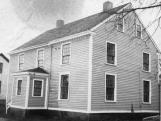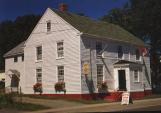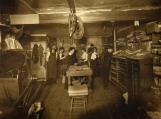1
Businesses are the lifeblood of every community, large and small. Digby has seen many come and go. Some never got beyond the planning stage. Some were short-lived ventures; others lasted decades. The town is experiencing something of an economic renaissance today with big corporations such as WalMart, Sobeys, the Great Atlantic Superstore, Movie Gallery and Swiss Chalet opening branches here. There are no empty stores. The new millenium is looking good for us.Digby lost most of its downtown business section during the great fire of 1899. It is indicative of the strong entrepreneurial spirit that many merchants opened up temporary premises soon thereafter. Despite horrific loses and very little, if any, insurance, it was business as usual. The enduring toughness embedded in local inhabitants from our early pioneer beginnings remains a key factor in our current upswing in development.
3
The County Incorporation Act of 1879 stated that each county was now responsible for building their own poor house. The Alms House was built in 1891. There was one prior to this but nothing is known about it. The Alms House became the "dumping grounds" for single mothers, children, the mentally ill. or anyone else who could not survive independently in the community. As always horror stories of abuse and neglect were familiar. The residents were often at the mercy of the keeper. One keeper , Guy Thomas, was said to have fed half of Digby from the Poor House. In 1963 the Alms House was closed. It burned down in 1995 by an arsonist.6
On April 28, 1924, the Digby Town Council gave its official and unanimous support to the proposal to establish a hospital in Digby.The Digby Courier, May 2, 1924, carried the following: "Digby to Have Hospital." The accompanying story detailed presentations made to Council by Dr. W. F. Read and Dr. Roberts in support of the hospital project. Also recorded was the unanimous passing by Council of a resolution that "The Town Council place itself onrecord as being in full sympathy with the project of a local hospital and that the Mayor, Town Clerk and Finance Committee be representatives from the Town Council on the Board of Management."
In his remarks Dr. Read said he felt "a small cottage hospital" was now a possibility for Digby. He said the need for thid was apparent to all and it would receive necessary support. He said it would mean "a great lesser expense in surgical operations." Dr. Roberts "spoke along similar lines" and noted that Miss. Hill had offered her home for use as a cottage hospital and would do all she could do to establish it. He said a cottage hospital could carry on quite successfully with some assistance. It would be a good assest for the town and the countryside. (Miss. Hill's home, later Brad's Store did become Digby's first hospital)
Some time following the Council session a meeting was held at the Court House to discuss and take action regarding the establishment of a cottage hospital for Digby. A headline in the Courier of the next week noted "Citizens Endorse Scheme to Establish Hospital Here." The accompanying article noted the public meeting at the Court House, presided over by the Mayor, Dr. E. DuVernet was largely attend. "A large number of ladies showed their interest in the movement by being present and taking part in the discussion." The Mayor reviewed the action to date and outlined what needed to be done to establish a semi-private hospital. He expressed regret at the unavoidable absence of Dr. Read and called on Dr. Roberts to explain the priject detail.
In his remarks Dr. Roberts noted the semi-private hospital would cost a good deal and the best Miss Hill could expect was to break even. He said the public was being asked to furnish a graduate nurse and pay the same. With a little effort, he said, on behalf of citizens place can be furnished where people from the town and country can come for treatment instead of going to Halifax and or Yarmouth. Dr. Roberts told the gathering the Women's Institute in Plympton were "already willing to donate a sum of money and this was only a beginning." In his address Dr. Roberts said, "if we can only save one life by having a hospital here then our labours would be well repaid." He said two ideas had been suggested regarding the hospital.
First to rent the house from Miss Hill and pay her for looking after the same, as well as being responsible for all expenses contracted. Second: to accept the proposition offered by Miss. Hill who is willing to take a chance and assume all responsibilities. If a committee would undertake to secure a nurse and purchase the necessary equipment Miss Hill's proposition to give her home would be accepted, the Doctor said. He noted a nurse could be secured for $60 a month. It was up to the meeting a decide, Dr. Roberts concluded. The Town Clerk, Mr. Boden, quoted figures relating to the probable cost of hospital service. He noted a Cottage Hospital in PIctou with 10 beds had cost $6, 768 the previous year. Receipts were $6, 875m. He said a deficit must be expected. Several other speakers expressed opinions regarding the hospital project. Mrs. T.E.G. Lynch felt an endowment fund would be necessary. Mrs. George Turnbull stated the only way to find out if a hospital would be a sucess in Digby would be to "go ahead and give it a trial for six months or a year."
At the conclusion of the presentations a motion was presented that the meeting express itself by a standing vote being in sympathy of the movement to start a semi-private hospital in Digby. "This was carried almost unanimously." A vote of thanks was also tendered Miss Hill by the meeting for her "kindness in operating her home in order to give the citizens an opportunity to have a hospital."
A nominating committee was appointed to select a delegate from each church to serve on the Board of Management with Council appointees. It was also noted the medical fraternity would serve on the Board. Elected to represent the Church of England was Miss Margaret Stewart: the Catholic Church. Mrs. H. Williams: Baptist, Mrs. H. Andrews; and Methodist. Mrs. E. H. Wightman.
In February 1925, the new hospital, which then had been in operation for some six months, applied to the Town Council for a grant of $500 in order that it might be incorporated and become a public hospital. A grant of $250 had been secured from the Municipality. A delegation of Dr.'s Read, Roberts, Dickie and DuVernet presented the grant request to the Town Council.
Dr. Dickie, in answering questions posed by Council members regarding the hospital and its grants request, said he felt the hospital could be operated for less than $7,000 a year. He acknowledged the hospital should have asked for a larger grant than $250 from the Municipality.
Dr. Roberts stated the hospital had been operating as a public hospital for the previous six months. He noted that when the hospital was incorporated it was the Board's intention to form a Women's Auxiliary who would look after all contriubutions and help finance the hospital by holding teas, etc.... He claimed the people in the County had donated a much larger sum than the town.
Dr. DuVernet stated, in explaining the matter of incorporation, that if no grant was forthcoming the hospital "will not carry on and will go out of business."
The Council took no action at its meeting on the request of the hospital an annual grant of $500. This was strongly criticized by the Digby Courier in an editorial, "Passing the Buck." This was followed by a second editorial a week later. This fully supported the hospital proposal and said in part, "What about the hospital? Do we want it? Do we need it? Can we afford it? The public answers Yes, Yes, Yes." The second editorial urged the public to attend the ratepayers meeting to deal with the grant request and to support the hospital.
The Courier of April 3, 1925 reported that a ratepayers meeting had been called to deal with a resolution, "Resolved, that the ratepayers of the Town of Digby authorize the Town Council to pass a resolution declaring the local hospital to be a Public Hospital, and to make an annual grant of $500.
According to a news story in the Courier April 10, 1925, the ratepayers did attend the meeting and voted strongly in support of the grant resolution with 45 voting in favour and 33 against. The front page news story of this meeting detailed many of the arguments for and against the resolution. The Council acted very quickly in calling a special meeting to declare the hospital a public hospital and make available a grant.
In the same issue it is told of a Ladies Auxiliary for the Hospital being formed. It was reported that the organizational meeting was told by its chairman that the hospital would be known as the "Digby General Hospital."
Fundraising activities for the Digby General Hospital seemed to be the order of the day in 1925 with teas, sales and dances being featured. One tea and sale was reported "A Big Success with a large sum realized for building fund of new Digby General Hospital." The tea sale was sponsored by the building fund and appears to be one of the earliest fundraising events directly sponsored by the building fund.
Article: Digby Hospital first established in 1924, was taken directly from printed form. The Courier - 1986
All above information is from the following website:
www.tartannet.ns.ca/hospital/dgh.html
9
Located in a full two-storey house, it is a 'Loyalist', or Georgian style building. The pilasters and cornice with return eaves suggest a construction prior to 1840. The land and house were owned by many different families, principally Woodrow and Dakin. From 1968 to 1977 the Digby Library Association operated a library in the house. At the same time a museum developed upstairs. In 1977 the museum took over the whole building as the Admiral Digby Library & Historical Society. It is still in operation today (2004).11
The Old Post Office:The disastrous fire of 1899 destroyed the then Post Office located in the Turnbull Block but, at least, the mail was saved. According to G. W. Arnold Burnham who grew up in the 1840's "the Post Office was then a small affair".
The Post Office (1903-1963) in this early photograph was quite a grand edifice, the focal point for the entire downtown area. Its handsome clock tower with four faces could be seen from any direction night, or day, owing to its illuminated dial.
13
The New Post Office:Since the town's beginning a number of homes and buildings have been built on this site. The first was Brigadier-General Timothy Ruggles large house. It has been argued that had the seasoned soldier chosen the revoluntionary cause he, not George Washington, would have been Commander-in-Chief of the Continental Army and, in due course, the first President of the United States.
His background was impressive--Harvard graduate, respected lawyer, Judge, Member of Legislature, then its Speaker. He had initially supported the rebels in their grievances. In fact he had presided over the first colonial conference, formally known as the Continential Congress of 1774.
The price of his loyalty was high. Before his escape north, his favourite daughter, Bathsheba--along with some others--was hung by the people of her town, perhaps in revenge for her father's decision to choose, what in their minds, was the wrong side.
During Digby's first, or second, election emotions ran high. Partisanship again came to the fore just as it had done in the former homeland. One political faction used Holdsworth's Tavern as its headquarters while it is believed the other faction assembled at the Ruggles' house.
A brook ran between the two properties and a stone bridge had been constructed to carry the traffic on Water Street across it. This bridge constituted a sort of 'no-man's land' where the two groups met and fought pitched battles.







